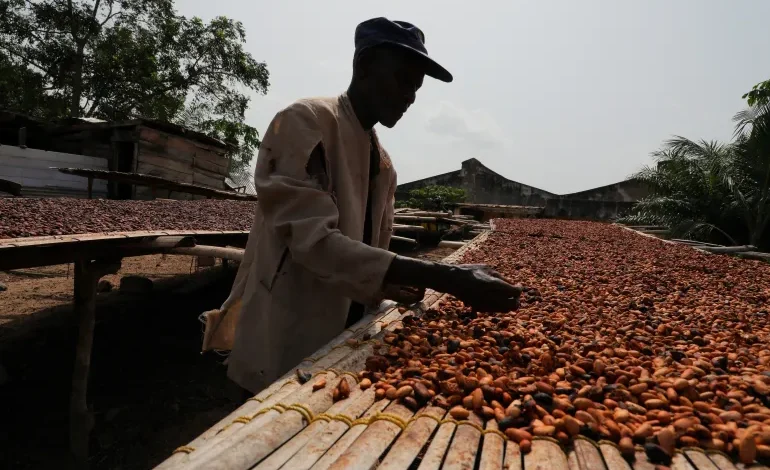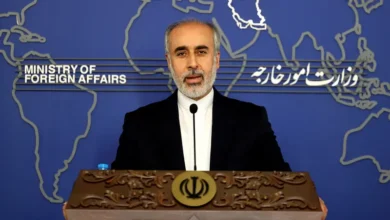Bitter truth: Why has chocolate become so expensive?

Cocoa prices surged almost 300 percent last year, making chocolate bars, Easter eggs and cocoa powder much more expensive this year than last.
In the United States, retail chocolate prices were one-fifth higher this Valentine’s Day compared with last year, according to Wells Fargo Bank. The price of a king-size US-sold Reese’s Hearts chocolate bar was 13 percent higher in February 2024 than in the same month the year before.
In the United Kingdom, meanwhile, a Twix white chocolate Easter egg rose in price from 5 to 6 pounds ($6.63 to $7.96) at Tesco supermarkets in the run-up to Easter (year-on-year) and was reduced in size from 316g (11oz) to 258g (9oz). In all, the unit price rose by a whopping 47 percent.
While the price of cocoa – the key ingredient in chocolate made from roasted raw cacao beans – has fallen back by about 20 percent since its all-time high in December 2024, consumers are still paying record prices for chocolate.
The spike in the price of cocoa can be chalked up to several factors. Chief among them is extreme weather, which has hit cocoa producers in West Africa, from where most of the world imports cocoa.According to Amber Sawyer, an analyst at the environmental think tank Energy and Climate Intelligence Unit (ECIU), expensive chocolate should not come as a surprise.
“Chocolate is just one of the many foods being made more expensive by climate change-driven extreme weather,” she said. “These extremes will keep getting worse.”
What has happened to the price of cocoa?
Benchmark New York futures contracts, used to exchange cocoa at a specified future date and price, hit a high of $12,565 per metric tonne in December 2024.
Last year’s meagre cocoa harvest led to record supply shortfalls, as poor weather and disease devastated crops in Ghana and the Ivory Coast, where two-thirds of the world’s cocoa beans are grown.Crop shortages were also observed in Nigeria and Indonesia, the third- and fourth-largest cocoa producers.
In all, there was a 500,000-tonne deficit of cocoa in global markets in 2024, which is continuing to keep prices high.
The latest cocoa harvest – which ran from October 2024 to March 2025 – did get off to a bright start, with 33 percent more beans arriving at Ivory Coast ports compared with last year, Commerzbank analyst Carsten Fritsch said in a note to clients.
But while the New York cocoa futures price is currently hovering at about $8,350 per tonne – a significant drop from December – concerns are growing that the same dry weather that wrecked last year’s crop will take a similarly devastating toll this year, Fritsch said.
The uncertainty is taking a toll on chocolate producers. Swiss chocolate maker Barry Callebaut slashed its annual sales forecasts on April 11 due to what it called “unprecedented volatility” in cocoa prices, sending its shares falling almost 20 percent – its biggest ever one-day drop.Weather
Volatile weather is one major factor. West Africa experienced extreme rainfall in 2023, with total precipitation more than double the 30-year average in some places, while 2024 saw extreme heat and drought.
Many climate scientists point to the El Nino weather phenomenon, which produces warmer-than-average sea surface temperatures in the central and eastern tropical Pacific Ocean, as the primary driver for volatile weather patterns. However, they also expect a transition to the La Nina pattern – the cooling of ocean surface temperatures in the central and east-central equatorial Pacific every three to five years – to revive cocoa yields at least temporarily.
Indeed, the International Cocoa Organization in February forecast a global cocoa surplus of 142,000 megatonnes for 2024-25, the first surplus in four years. That partly explains the recent fall in price.
But according to Felipe Pohlmann Gonzaga, a Switzerland-based commodity trader, the larger picture of “climate change is only going to make supply concerns worse” in the longer term.
Scientists at the research group Climate Central published a paper this year showing that climate change compromised cacao trees during the harvest season in Ivory Coast and Ghana.
Laws against deforestation
Besides changing weather patterns, several other issues are also driving recent price hikes in cocoa.
Across West Africa, new deforestation laws have prevented farmers from expanding cocoa plantations, keeping a lid on supply.










